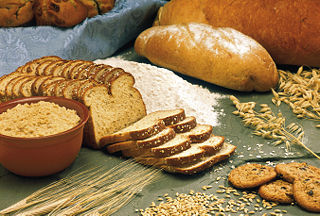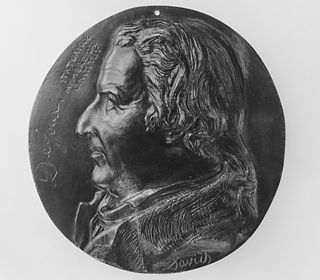

Pierre-Philippe-André Levêque de Vilmorin (November 30, 1776 - March 21, 1862), more commonly known as Philippe André de Vilmorin, was a notable French horticulturist.

France, officially the French Republic, is a country whose territory consists of metropolitan France in Western Europe and several overseas regions and territories. The metropolitan area of France extends from the Mediterranean Sea to the English Channel and the North Sea, and from the Rhine to the Atlantic Ocean. It is bordered by Belgium, Luxembourg and Germany to the northeast, Switzerland and Italy to the east, and Andorra and Spain to the south. The overseas territories include French Guiana in South America and several islands in the Atlantic, Pacific and Indian oceans. The country's 18 integral regions span a combined area of 643,801 square kilometres (248,573 sq mi) and a total population of 67.3 million. France, a sovereign state, is a unitary semi-presidential republic with its capital in Paris, the country's largest city and main cultural and commercial centre. Other major urban areas include Lyon, Marseille, Toulouse, Bordeaux, Lille and Nice.

Horticulture has been defined as the culture of plants for food, comfort and beauty. A more precise definition can be given as "The cultivation, processing, and sale of fruits, nuts, vegetables, ornamental plants, and flowers as well as many additional services". It also includes plant conservation, landscape restoration, soil management, landscape and garden design, construction, and maintenance, and arboriculture. In contrast to agriculture, horticulture does not include large-scale crop production or animal husbandry.
Vilmorin was the oldest son of Philippe-Victoire Levêque de Vilmorin (1746-1804), founder of a commercial agricultural establishment, studied at the college of Pont-le-Voy and subsequently Paris, and became the company's head upon his father's death. His travels to England in 1810, 1814, and 1816 allowed him to see first-hand the advances in English plant cultivation for horticulture and agriculture, and furthered his active interest in cereals, vegetables, forestry, and ornamental and exotic plants. The London Society of Horticulture presented him with its grand medal in 1814 for his numerous articles on these subjects.

England is a country that is part of the United Kingdom. It shares land borders with Wales to the west and Scotland to the north-northwest. The Irish Sea lies west of England and the Celtic Sea lies to the southwest. England is separated from continental Europe by the North Sea to the east and the English Channel to the south. The country covers five-eighths of the island of Great Britain, which lies in the North Atlantic, and includes over 100 smaller islands, such as the Isles of Scilly and the Isle of Wight.

Agriculture is the science and art of cultivating plants and livestock. Agriculture was the key development in the rise of sedentary human civilization, whereby farming of domesticated species created food surpluses that enabled people to live in cities. The history of agriculture began thousands of years ago. After gathering wild grains beginning at least 105,000 years ago, nascent farmers began to plant them around 11,500 years ago. Pigs, sheep and cattle were domesticated over 10,000 years ago. Plants were independently cultivated in at least 11 regions of the world. Industrial agriculture based on large-scale monoculture in the twentieth century came to dominate agricultural output, though about 2 billion people still depended on subsistence agriculture into the twenty-first.

A cereal is any grass cultivated for the edible components of its grain, composed of the endosperm, germ, and bran. The term may also refer to the resulting grain itself. Cereal grain crops are grown in greater quantities and provide more food energy worldwide than any other type of crop and are therefore staple crops. Edible grains from other plant families, such as buckwheat (Polygonaceae), quinoa (Amaranthaceae) and chia (Lamiaceae), are referred to as pseudocereals.
In 1815 Vilmorin established Vilmorin-Andrieux et Cie, which ultimately became one of the world's largest suppliers of plants, and acquired a former hunting lodge of Louis XIV of France just outside Paris, which he developed into the Arboretum Vilmorin. In 1821 he purchased the Domaine des Barres (283 hectares), upon which he created an experimental forest, parts of which have now become the Arboretum national des Barres. Vilmorin died at Barres on March 21, 1862.

Louis XIV, known as Louis the Great or the Sun King, was a monarch of the House of Bourbon who reigned as King of France from 1643 until his death in 1715. Starting on 14 May 1643 when Louis was 4 years old, his reign of 72 years and 110 days is the longest recorded of any monarch of a sovereign country in European history. In the age of absolutism in Europe, Louis XIV's France was a leader in the growing centralisation of power.
The Arboretum Vilmorin is a private arboretum located at 2 rue d'Estienne d'Orves, Verrières-le-Buisson, Essonne, Île-de-France, France. It is open by appointment only. A newer portion of the family arboretum was acquired by the municipality in 1975, and is now open to the public as the Arboretum municipal de Verrières-le-Buisson.

The Arboretum national des Barres is a national arboretum located in Nogent-sur-Vernisson, Loiret, Centre-Val de Loire, France. It is open daily in the warmer months; an admission fee is charged. Closure is planned for the end of year 2018 because subsidy from local and national government is too short.










